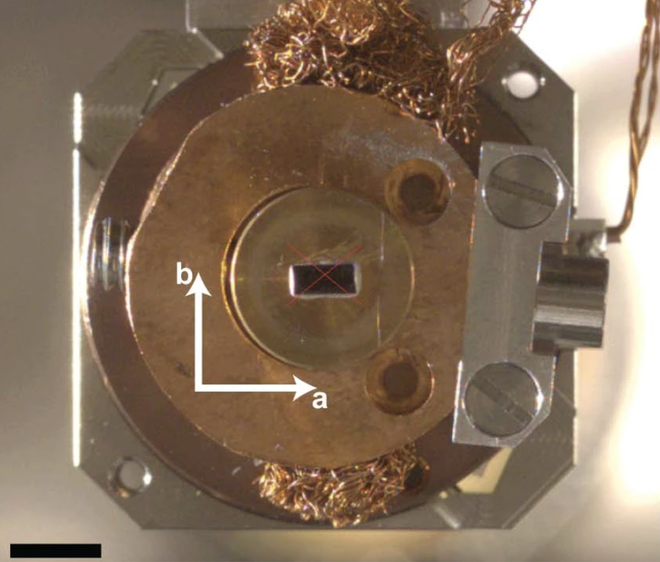An elusive particle proposed in 1956 by theoretical physicist David Pines has just been discovered by a team of scientists led by Peter Abbamonte of the University of Illinois.
Scientists long suspected that this particle, called a ‘demon’, plays a fundamental role in the characteristics of several metals, but had been unable to confirm its existence thus far.
“Demons have been theoretically conjectured for a long time, but experimentalists never studied them,” Dr. Abbamonte said of the discovery in a press release. “In fact, we weren’t even looking for it. But it turned out we were doing exactly the right thing, and we found it.”
The demon is not a particle in the conventional sense of the term. Instead, it is a collection of particles, or a composite particle, made of electrons. (Protons are another example of a composite particle; they are made up of quarks.)
From excitation to plasmon
In a solid, electrons can interact to form collective units, or excitations. This possibility was one of the fundamental discoveries in condensed-matter physics. One example of an excitation is a denser group of electrons in one part of the solid relative to another.
If supplied with enough energy, these excitations can form a composite particle called a plasmon.
Imagine excitations to be ripples in a pond. Now imagine a continuous wind that keeps adding energy to these ripples.
The added energy makes these ripples combine to become a larger wave. This is what happens in a solid: the denser group of electrons, when provided with energy, come together to form the composite particle, the plasmon.
However, due to insufficient energy, plasmons can’t form at room temperature.
From plasmon to demon
The electrons in a solid are organised into distinct energy levels, or energy bands. If an electron has a certain amount of energy, it is said to belong to one of the bands. Each band represents a range of energies that electrons can have.
When supplied with more energy, electrons can jump from one energy band to another. The movement of these electrons plays a pivotal role in the behaviour and properties of materials.
Pines, the physicist, found that if a solid has electrons in more than one energy band – i.e. if the electrons occupied more than one energy level – their individual plasmons could interact to form a new and massless composite particle, the demon.
In simpler terms, imagine two groups of electrons moving in opposite directions but in perfect coordination. This out-of-sync movement of charges and energies results in the formation of the demon particle.
What sets the demon apart is that it has no mass and no charge, which allows demons to form at any temperature, defying the usual limitations.
Pines playfully coined the term ‘demon’ as a backronym, inspired by the ‘-on’ suffix of particle names and the distinct electron motion (“dem-”).
Eluding discovery
The very thing that sets the demon apart is also the reason for its elusive discovery: its lack of charge.
The demon is neutral, so it can’t interact with electromagnetic radiation, or light.
“The vast majority of experiments are done with light and measure optical properties, but being electrically neutral means that demons don’t interact with light,” Dr. Abbamonte said in the statement.
The interaction between the electric and magnetic fields in light and charged particles leaves a trace or signature in conventional experiments. Detecting demons required a fresh approach, and that is what Dr. Abbamonte and his team did.
A happy accident
The researchers were originally studying the properties of strontium ruthenate, a metal that becomes a superconductor in some conditions. Their primary objective was to study its electronic properties.

The team synthesised high-quality samples of strontium ruthenate and analysed them using a cutting-edge technique called momentum-resolved electron energy-loss spectroscopy.
In this approach, electrons are directed into the metal while a detector records their energy loss. This information provides unique insights into the material’s electronic features. When they analysed the data, they found something unexpected: an electronic mode with no mass.
The first author, Ali A. Husain, said the team initially had no idea what this was: “Demons are not in the mainstream. The possibility came up early on, and we basically laughed it off. But as we started ruling things out, we started to suspect that we had really found the demon.”
To verify their discovery, the team conducted detailed microscopic calculations. They revealed a composite particle composed of two plasmons, oscillating out of phase with almost the same magnitude.
This was definitive proof of the existence of a demon particle within the strontium ruthenate samples.
Beyond the theoretical
The discovery matters for several reasons.
Science thrives on curiosity and delving into the unknown. The story of Pines’ demon is a testament to this ethos and how, in science, we never know what we may find.
Dr. Abbamonte dubbed the discovery serendipitous: “It speaks to the importance of just measuring stuff. Most big discoveries are not planned. You go look somewhere new and see what’s there.”
The discovery also sheds light on the intricate and complex world of quantum mechanics, which is often misunderstood. The world is very different at the subatomic scale at which quantum mechanics operates.
The demon also has a potential role in why some metal hydrides become superconducting – a possibility that has ignited excitement in the scientific community.
Superconductivity is the phenomenon in which electricity flows without resistance in a material. While it has transformative applications from efficient energy transmission to advanced medical devices, researchers are yet to find a material that becomes superconducting at room temperature and pressure.
Understanding the demon’s influence on a material’s superconductivity could unlock new ways to achieve superconductivity at higher temperatures.
- An elusive particle proposed in 1956 by theoretical physicist David Pines has just been discovered by a team of scientists led by Peter Abbamonte of the University of Illinois. Scientists long suspected that this particle, called a ‘demon’, plays a fundamental role in the characteristics of several metals, but had been unable to confirm its existence thus far.
- The demon is not a particle in the conventional sense of the term. Instead, it is a collection of particles, or a composite particle, made of electrons. (Protons are another example of a composite particle; they are made up of quarks.)
- Pines, the physicist, found that if a solid has electrons in more than one energy band – i.e. if the electrons occupied more than one energy level – their individual plasmons could interact to form a new and massless composite particle, the demon.
Tejasri Gururaj is a freelance science writer and journalist.







